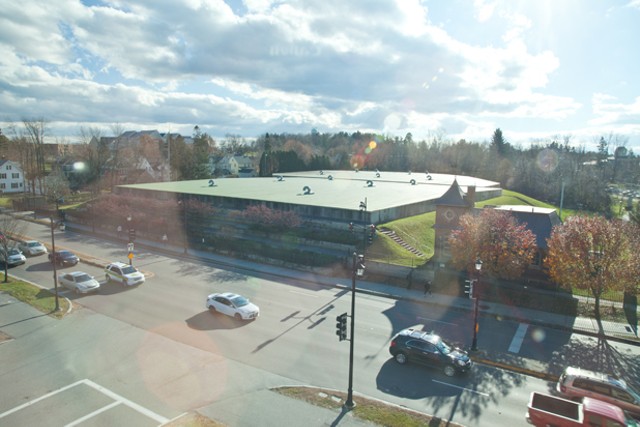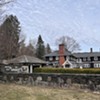Published November 20, 2013 at 7:12 a.m.
Tourists, students and local residents who pass the University of Vermont campus on Burlington’s Main Street may never give a second glance to a small, one-story brick building on its south side. Bordered by trees and an iron fence, the building faces the Dudley H. Davis Center but isn’t technically part of UVM. And, despite the building’s quaint, inviting architecture, it has no entrance from Main Street. Instead, multiple signs indicate the presence of surveillance cameras, warning, “Trespassers will be prosecuted.”
This small, historic structure and the two reservoirs behind it are among the oldest and most crucial pieces of infrastructure in the Queen City. The Main Street pump house and city reservoirs, built nearly 150 years ago, provide Burlingtonians with a healthy and reliable source of drinking water.
“Is it still in use?” a reader asked WTF recently. It is. In fact, Burlington wouldn’t be the city it is today without the pump house.
In the mid-1800s, many residents got their water from wells, springs or cisterns. Given the difficulty of sinking wells deep enough to strike a water vein, many others hauled water from Lake Champlain or the Winooski River.
In 1850, Frederick Smith, a prominent local businessman, founded the Burlington Aqueduct Company to supply the town with water. Replacing old wooden pipes that dated to the 1820s, Smith laid three miles of iron pipes throughout the city to furnish mostly wealthy citizens with water directly to their homes.
In 1866, just a year after Burlington was incorporated, the city’s new health officer, Samuel Thayer, conducted a sanitary survey. Calling the city’s water supply its “lifeblood,” he wrote in his report, “If we were to estimate the degree of vitality possessed by the city of Burlington by the quality of water circulating through it, we should be found to consider it an almost bloodless and very feeble city.” Ouch!
That same year, in a process all too familiar to 21st-century residents, the city issued $150,000 in municipal bonds to build a new water system, which included $24,000 to buy the Burlington Aqueduct Company. In 1867, the city built the pump house and the first of the two reservoirs. Water began flowing on Christmas Day 1867, marking the start of one of the finest public water systems in Vermont.
The first reservoir, which holds nearly 3 million gallons, was initially left uncovered and open to the public; a second open-air reservoir, which holds 4 million gallons, was built in 1888. Steve Goodkind, Burlington’s former director of public works, says that for decades it wasn’t uncommon for Burlingtonians to use the reservoirs for skating in the winter and — as unhygienic as it seems today — for swimming in the summer.
According to a 1988 conservation report on the pump house by Heather Rudge of UVM’s historic preservation program, Burlington initially chlorinated its water by dissolving chlorine powder in a large crock, then placing it in the back of a rowboat. A city employee would row the boat around the reservoir, dripping chlorine solution into the water. It wasn’t until 1952 that the city built an automated chlorination system, thus eliminating what was surely an undesirable job.
“The high technology of the reservoir and the availability of water to the citizens of Burlington,” Rudge wrote in 1988, “overshadowed the fine architectural character of the pump house at the time of its construction.”
In fact, though the reservoirs were little more than shallow, concrete-lined ponds, there’s more historical documentation on their construction than on the pump house itself, which is now part of the University Green Historic District and listed on the National Register of Historic Places.
The building is made of red brick, with a curved slate roof and various circular, semicircular and quarter-oval windows. It has a chimney, a wrought-iron weathervane on the roof of the tower and lots of ornamental detailing. These and other improvements were meant to attract residents to recreate there and, according to an 1868 report by the water works’ chief engineer, to “improve not only the taste but the morals of the community.”
Although the pumps themselves have been upgraded several times since the pump house was built, surprisingly little else has changed, according to Laurie Adams, assistant director of public works.
Both reservoirs, which were eventually capped for safety reasons, still store most of the water used in the city — an average of 4.5 million gallons a day. The city’s highest elevations, including the UVM campus, Fletcher Allen Health Care and the Hill Section, draw their water from one of two elevated tanks: the half-million-gallon one adjacent to the hospital, and the quarter-million-gallon tank on the Redstone campus. But the 7-million-gallon reservoirs are still the city’s mainstay for drinking water, which is pumped uphill from the waterfront treatment plant.
And, as Adams notes, those reservoirs are due for maintenance. Some time in the next year or two, the Burlington Water Department needs to replace the rubber liners inside, which were first installed in the 1980s. Adams has no current estimate of the cost of doing so, but predicts, “It’ll be a lot.”
Whether Burlington taxpayers will pony up for something as vital as their public water system remains to be seen. Adams offers a suggestion she heard recently from a customer: On the model of the Penny for Parks campaign, she says, perhaps it’s time for Penny for Pipes. Water, after all, is our lifeblood.
More By This Author
About the Artist

Matthew Thorsen
Bio:
Matthew Thorsen was a photographer for Seven Days 1995-2018. Read all about his life and work here.
Matthew Thorsen was a photographer for Seven Days 1995-2018. Read all about his life and work here.
Speaking of...
-

Records Show UVM Professors Questioned Decision to Nix Palestinian Writer’s Appearance
Dec 20, 2023 -

UVM Strikes Deal With Burlington That Could House More Students on Campus
Dec 18, 2023 -

Burlington Area Selected as Semiconductor 'Tech Hub'
Oct 25, 2023 -

UVM Students Protest Cancellation of Palestinian Writer's Appearance
Oct 24, 2023 -

As UVM Student Body Grows, In-State Enrollment Remains Low
Aug 21, 2023 - More »
Comments
Comments are closed.
From 2014-2020, Seven Days allowed readers to comment on all stories posted on our website. While we've appreciated the suggestions and insights, right now Seven Days is prioritizing our core mission — producing high-quality, responsible local journalism — over moderating online debates between readers.
To criticize, correct or praise our reporting, please send us a letter to the editor or send us a tip. We’ll check it out and report the results.
Online comments may return when we have better tech tools for managing them. Thanks for reading.














































